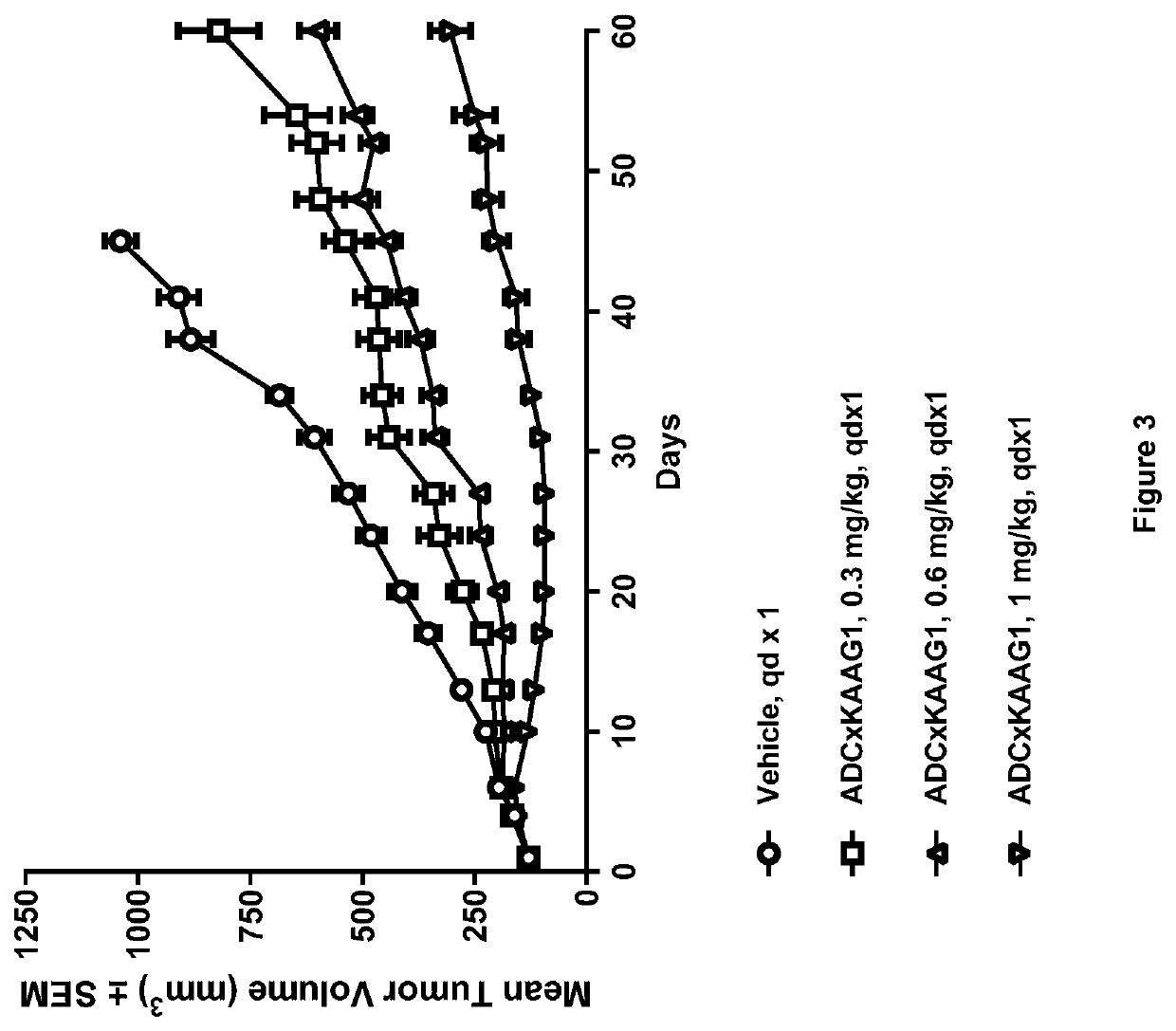Pyrrolobenzodiazepine-antibody conjugates
a technology of pyrrolobenzodiazepine and conjugates, which is applied in the direction of bulk chemical production, drug compositions, peptides, etc., can solve the problems of inability to discern the distribution of p (drug) values, inability to scavenge by other thiol-containing biological molecules, and inability to accept normal cell toxicity levels
- Summary
- Abstract
- Description
- Claims
- Application Information
AI Technical Summary
Benefits of technology
Problems solved by technology
Method used
Image
Examples
embodiments
[0723]Embodiments of the present disclosure include ConjA wherein the antibody is as defined above.
[0724]Embodiments of the present disclosure include ConjB wherein the antibody is as defined above.
[0725]Embodiments of the present disclosure include ConjC wherein the antibody is as defined above.
[0726]Embodiments of the present disclosure include ConjD wherein the antibody is as defined above.
[0727]Embodiments of the present disclosure include ConjE wherein the antibody is as defined above.
[0728]As mentioned above, some embodiments of the disclosure exclude ConjA, ConjB, ConjC, ConjD and ConjE.
[0729]Drug Loading
[0730]The drug loading is the average number of PBD drugs per antibody, e.g. antibody. Where the compounds of the disclosure are bound to cysteines, drug loading may range from 1 to 8 drugs (DL) per antibody, i.e. where 1, 2, 3, 4, 5, 6, 7, and 8 drug moieties are covalently attached to the antibody. Compositions of conjugates include collections of antibodies, conjugated wit...
example 1
of Conjugates
[1215]Generation of ADCs
[1216]Anti-KAAG1 antibody 3A4 (with the VH and VL sequences Seq 1 and Seq 2, respectively) was conjugated with drug linker E to give ADC×KAAG1 by the following method.
[1217]3A4 in 30 mM Histidine, 200 mM sucrose, pH 6.0 was adjusted to pH 7.5 with 500 mM Tris, 25 mM EDTA, pH 8.5 and reduced for 90 min by the addition of 1.24 molar equivalents of TCEP at 18-22° C.
[1218]Conjugation was done by adding 4 molar equivalents of 10 mM SG3249 (aka. Drug linker E) in DMA for 90 min at 18-22° C. and the reaction was quenched by adding 8 molar equivalents of N-acetylcysteine for 30 min at 18-22° C.
[1219]The pH was adjusted to 6.2 by adding 400 mM Histidine-HCl, pH 4.0 and the conjugate was filtrated across a 0.2 μM filter. The conjugate was diafiltered using 12 diavolumes of 30 mM Histidine, 175 mM sucrose, pH 6.0 with Pellicon 3 Ultracell membranes.
[1220]The ADC was diluted to a final protein concentration of 5 mg / ml with 30 mM Histidine, 175 mM sucrose, pH...
example 2
Cytotoxicity of ADCs
[1224]Cell Culture
[1225]PC3, SN12C, and SKOV3 cells were used.
[1226]In Vitro Cytotoxicity Assay
[1227]Cells growing exponentially at 80-90% confluence were washed with PBS, detached (where appropriate) with Trypsin-EDTA (0.25%) and resuspended in cell specific media. Cells were then diluted to 6×104 cells / ml and 50 μl / well was aliquoted into labelled white 96-well flat bottom white clear plates.
[1228]A 400 μl stock solution of each ADC was made to a concentration of 20 μg / μl, by dilution of the filter-sterilised ADC in cell growth medium.
[1229]Using this stock solution a 1:5 fold dilution range was then made to produce a set of 7 dilutions; 50 μl of each ADC dilution (including the stock solution) was dispensed into 2 replicate wells of the labelled white 96-well flat bottom plate, containing 50 μl cell suspension.
[1230]Media Control: 100 μl of cell growth medium dispensed into 2 replicate wells.
[1231]Cell Line Control: 50 μl of cell growth medium+50 μl cell suspe...
PUM
| Property | Measurement | Unit |
|---|---|---|
| volume | aaaaa | aaaaa |
| doubling time | aaaaa | aaaaa |
| doubling time | aaaaa | aaaaa |
Abstract
Description
Claims
Application Information
 Login to View More
Login to View More - R&D
- Intellectual Property
- Life Sciences
- Materials
- Tech Scout
- Unparalleled Data Quality
- Higher Quality Content
- 60% Fewer Hallucinations
Browse by: Latest US Patents, China's latest patents, Technical Efficacy Thesaurus, Application Domain, Technology Topic, Popular Technical Reports.
© 2025 PatSnap. All rights reserved.Legal|Privacy policy|Modern Slavery Act Transparency Statement|Sitemap|About US| Contact US: help@patsnap.com



